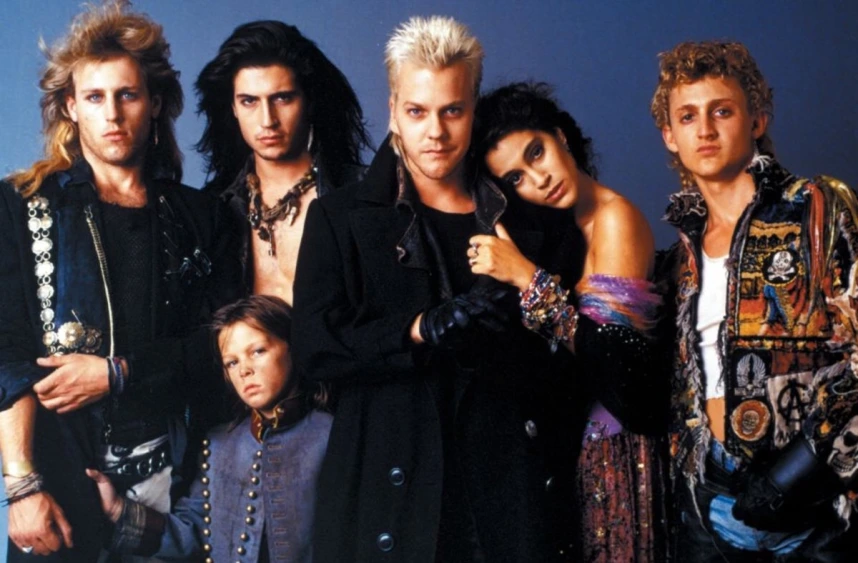Thesis: Has the soundtrack to the 1987 film The Lost Boys stood the test of time?

Method: Eh. Watch the film a couple of times and listen to the relevant tracks? Maybe? That’s sounds good, right?
Discussion: Full disclosure, here: I am a metal head. Pop music doesn’t really do it for me in an entertainment capacity. Of course, there are exceptions, but the wider genre of pop music isn’t my jam. To damage my credibility even more, I’m no music expert. Musical terms, construction, and general minutiae are a wee bit beyond me. This is going to turn out fine, though, just dandy.
So why have I decided to comment on a soundtrack that, while it does tippy-toe into rock, is mostly a pop amalgamation? The Lost Boys is one of my favourite films and I decided it would be fun to do. As a result, everything I say here will be based what the kids call veebs. Vibbays? Vebbs?
You know what I mean.
I could give (yet another) ranking of Friday the 13th films. It would include the nugget of why I detested part five. But, really, don’t you want something a bit more wholesome and uplifting?
The music I’m talking about is (mostly) the material from the soundtrack and not the score, just for clarity.
And there will be minor spoilers for the film. Shouldn’t need to warn people about an almost forty-year-old film, but this is the internet and there are a lot of people with unsettlingly twitchy eyes who get upset about these things.
This probably should’ve been under the “method” bit, but I’ll be going through the songs in the order they appear in The Lost Boys , not the Official Soundtrack listing. Just because that’s how I’m feeling today.
We start even before the cold open with the WB studio ident and the child singing eerily. Which moves us into the opening strains of “Cry Little Sister (The Theme from The Lost Boys)”by Gerard McMann, and yes, the parenthesis does seem to be part of the title. For me, this is the song that defines the film. It lives up to its bracketed title by having bits of it played four times during the duration. Wish I had something funny to say about it, other than eyebrow-waggling about its synthy eighties-ness, but it’s a creepy, soaring, and earnest power ballad that fits well with the subject matter.
I promise I will start saying funnier (or funny adjacent) things later.
Next, we have — oh, hello, there! What are you doing here, you little fragment from the score? Did you get lost? Aren’t you all cute and quaint, with your throwback name and fairground sound? No, I didn’t have stroke, I’m talking about “To the Shock of Miss Louise” by Thomas Newman. Seriously, this piece sounds like it should be part of the score and for very good reason:
Thomas Newman composed the score with its synthy collection of organ music and drum machines. This one-minute-twenty-something second oddity sounds like it involved a full orchestra and manages a surprisingly unsettling bit in the middle as it veers into some atonal playing. It’s a bit of a wild tangent, musically, from the other songs.
“People Are Strange” by Echo and the Bunnymen is the first cover of the group. Along with “Cry Little Sister (The Theme from The Lost Boys)” this sets the tone for the rest of the film. It’s a fairly faithful rendition of The Doors’ original, with an added smidge of gloomy goth swagger provided by the performers.

The second cover to make itself known is the performance of Conan the Saxophonist himself, Tim Capello, of “I Still Believe”. I only discovered this was a cover of a The Call song when I started looking into doing this whole exercise. It was also the reason I saddled myself with the task. On the fateful rewatch I was amused at how much headbanging and air-punching there was for an absolutely middle-of-the-road song. I would’ve forgotten it was playing if it weren’t for Capello’s baby-oiled torso and hopefully not baby-oiled screaming sax insertions. It’s not bad per se, just a bit of a musical shrug.
And talking about musical shrugs there’s “Laying Down the Law” by INXS and Jimmy Barnes. Going by the title and the snippet of Jimmy Barnes’s gravelly, fry-laden voice singing one of the verses, you’d think this would be a lot more interesting. The rest of the song lapses into some kind of fugue, with Barnes and Michael Hutchence listlessly handing off lines to one another like a slow public game of pass the parcel using the very concept of the colour beige. Astonishingly boring and it might be the first properly bad song on the soundtrack.
The eighties could get quite wacky. There’s no doubting that. So much cocaine. Not that I think the band that brought us “Beauty Has Her Way” were on cocaine, or drugs of any kind. That band being called Mummy Calls.
…
Hm. Well, that’s not a smoking gun. We can’t say for definite, but we can smirk a bit and give a knowing nod to that one. Chemical consumption aside, “Beauty Has Her Way” is a fine and tinkly pop song. We’re treated to more earnestness here, not that I’m entirely sure what the earnestness is about.
(But, really, Mummy Calls?)
Cover number three comes up now. This is “Good Times” by INXS and Jimmy Barnes again, originally performed by The Easybeats. This feels like a do-over for the collab’s woeful first contribution. I don’t know how this compares to the original, but this is quite the adrenalised and bouncy affair. Where “Laying Down the Law” is a couple of guys sighing and grumbling, “Do we have to?” this one is more like those same two guy shouting, “Ha ha! Fuck yeah!” It’s fun and the lyrics are mildly insane. The song hilariously soundtracks the “death by stereo” moment in the climactic face-off.
Remember when I said the soundtrack tippy-toes into rock earlier? That’s not quite accurate. “Lost in the Shadows” by Foreigner lead singer Lou Gramm leaps full-body into rock and almost slides headlong and screaming into heavy metal. If there were crunchy guitars and the drums weren’t so machiney this would be saying, “all right, mate?” to Iron Maiden and Def Leppard. An aggressively driving beat compels this little ditty forward and the video is incredibly stupid, even more so given Lou Gramms eye-ball drying intensity.
While it wasn’t on the soundtrack album, almost certainly a casualty of some simple (read: brain-twistingly complicated) and good-natured (read: murderously serious) rights issues, I must mention “Walk this Way” by Run-DMC featuring Aerosmith. By far the most famous and widely-known song here. It’s hard to really say much about a song that could be called a major cultural artefact, so I’ll step away with my hands up.
Closing out the credits, after the last run-through of “Cry Little Sister (The Theme from The Lost Boys)” is Roger Daltrey’s cover of “Don’t Let the Sun Go Down on Me” originally performed by Elton John. It’s amazing that a song with such a ridiculously long title can be taken seriously, which says a lot about the writing. This version is close to the original, but is given a bit more of a dramatic twist in the arrangement and in Roger Daltrey’s vocal-fry-laden performance. It is truly insanely dramatic. So dramatic that it almost feels like it belongs in another film soundtrack.
There’s one song that I was reluctant mention here. It is on the soundtrack album. It’s also mentioned in the closing credits to the film, but here’s the thing: I don’t remember hearing it. I’ve seen The Lost Boys numerous times over the years, and I watched it closely for this and still nothing. The song in question is “Power Play” by Eddie and the Tide. I feel like I’ve gone nuts and need to put a missing poster up for this song.
Okay, that’s not true. I listened to it before this re-watch and I can’t now remember what it sounds like. Another forgettable clunker and probably best it’s buried as being a virtually invisible two bars somewhere while interesting things are happening on screen.
Conclusion: Did you expect me to say, “nah this is shite?” Despite a couple of rubbish efforts, the whole package is solid and made my cynical face crack (literally, argh! No, not really) into a smile. On its own a pleasant listen and pieces are used at hilariously on-the-nose moments. One of those eighties snapshots that doesn’t quite encompass the decade, but it’s fun and nostalgic enough to make it a pleasant fantasy that it does.
Further Reading
HALLOWEEN’S SEQUEL ADDICTION BY WILLIAM COUPER

William Couper is a writer from Scotland. As well as the occasional article, he writes horror, fantasy, and science fiction. His fiction has featured in Penumbric Speculative Fiction Magazine, Cosmic Horror Monthly, The Horror Zine, Black Sheep Magazine, and Schlock Webzine. He lives with his wife and a multitude of cats.
Bluesky: bsky.app/profile/willcouper.bsky.social
Further Reading
If you’re a fan of spine-chilling tales and hair-raising suspense, then you won’t want to miss the horror features page on The Ginger Nuts of Horror Review Website. This is the ultimate destination for horror enthusiasts seeking in-depth analysis, thrilling reviews, and exclusive interviews with some of the best minds in the genre. From independent films to mainstream blockbusters, the site covers a broad spectrum of horror media, ensuring that you’re always in the loop about the latest and greatest.
The passionate team behind The Ginger Nuts of Horror delivers thoughtful critiques and recommendations that delve into the nuances of storytelling, character development, and atmospheric tension. Whether you’re looking for hidden gems to stream on a dark and stormy night or want to explore the work of up-and-coming horror filmmakers, this page is packed with content that will ignite your imagination and keep you on the edge of your seat.
So grab your favorite horror-themed snacks, settle into a cozy spot, and immerse yourself in the chilling world of horror literature and film. Head over to The Ginger Nuts of Horror and embark on a journey through the eerie and the extraordinary it’s an adventure you won’t soon forget!
